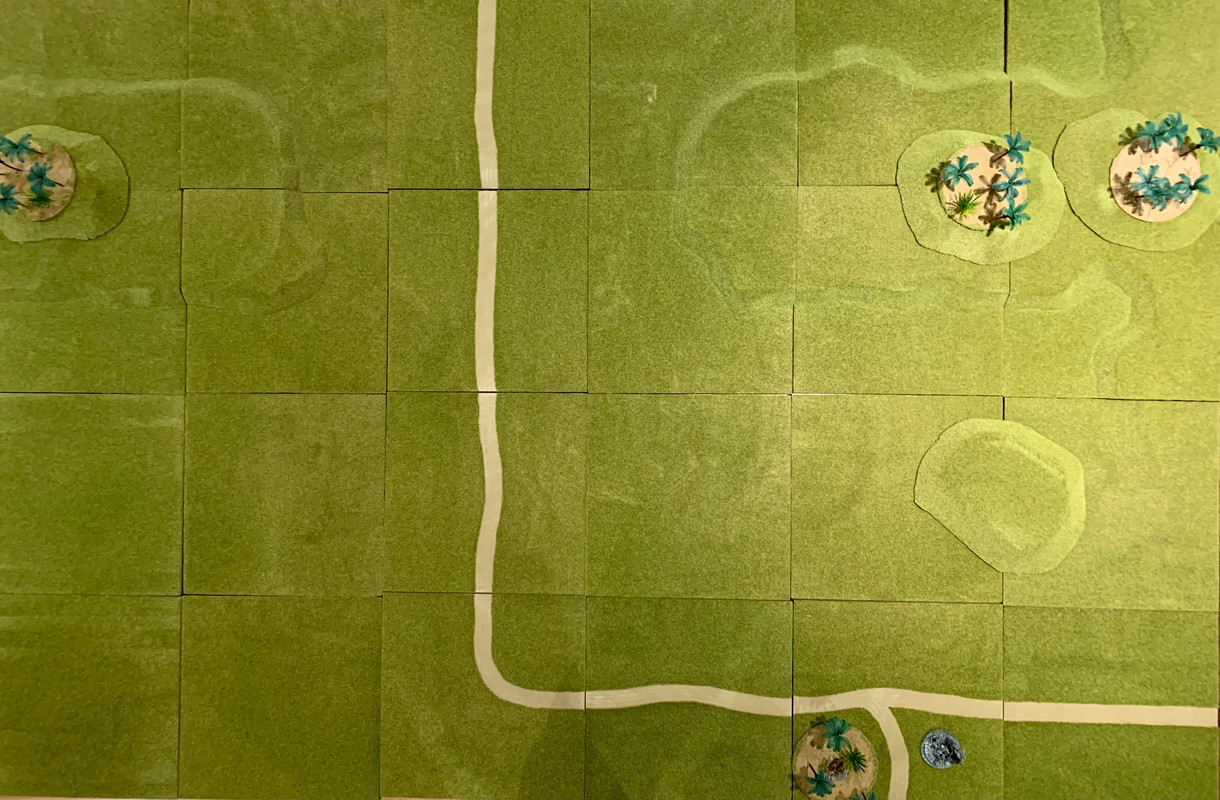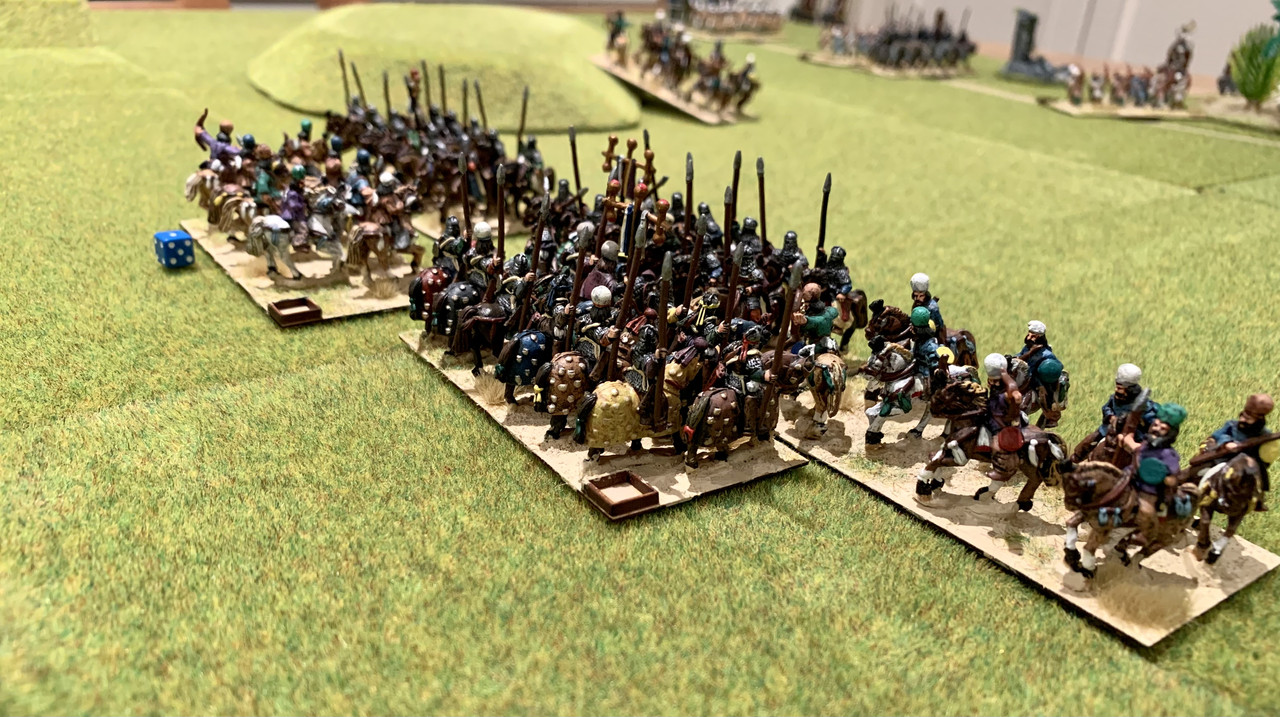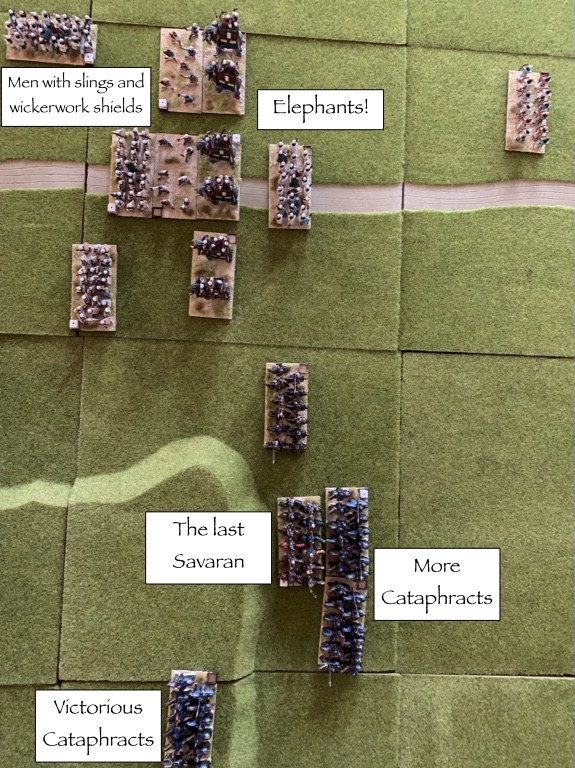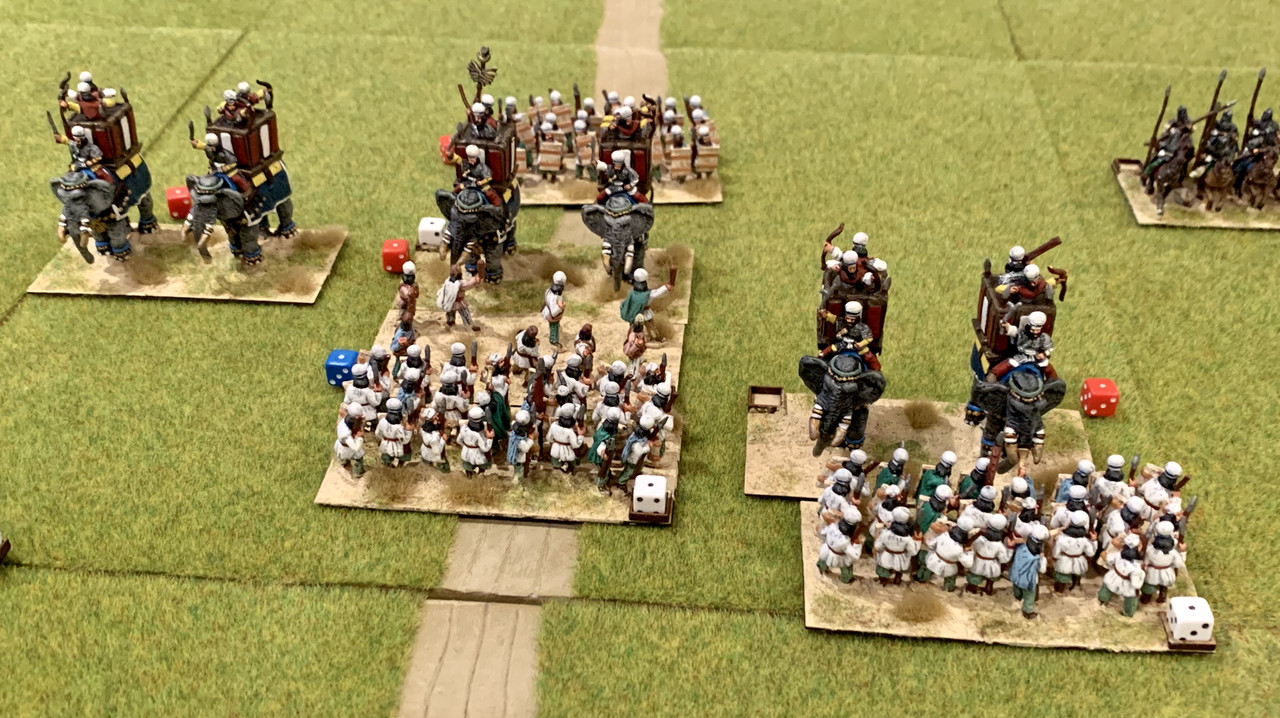Two months without a post? That’s more like the kind of pace I expected from this blog. The usual real world excuses plus, in keeping with my refusal to do anything until it has long ceased to be trendy (see this blog), I managed to have Covid. Not a severe case, but enough to give my mojo a severe kicking. However, with a little help from a long weekend, I managed Scenario 3 and my first Ancients game of the project.
Yes, I know the author (or his editors) use fewer s's than me, but I'm sticking with Kaveh Farrokh (or his editors).
So my Byzantines are for the early 6th century CE, or at least they will be when they're painted, and conveniently around this time the Sassanian Sahansah Hormizd IV, who favoured the landed gentry (dehgans) over the nobility (savaran) was being overthrown in favour of his son, Khusro II. So this scenario pitches a delaying force of the savaran trying to hold out against Hormzid’s army until nightfall.
Grant's companion volume, Programmed Wargame Scenarios, describes ancient forces in terms of percentages of Scouting, Skirmish, Line, Shock and Support. Combining these with the army lists for Scenario 3, plus some vaguely historical assumptions (elephants were the property of the Sahansah, cataphracts represent the Sahansah's personal bodyguard) I came up with the following forces that make use of all the units I have painted.
The rebellious Savaran (Blue)
1 unit horse archers
3 units slingers
3 units levy infantry
Grant's companion volume, Programmed Wargame Scenarios, describes ancient forces in terms of percentages of Scouting, Skirmish, Line, Shock and Support. Combining these with the army lists for Scenario 3, plus some vaguely historical assumptions (elephants were the property of the Sahansah, cataphracts represent the Sahansah's personal bodyguard) I came up with the following forces that make use of all the units I have painted.
The rebellious Savaran (Blue)
1 unit horse archers
3 units slingers
3 units levy infantry
3 units savaran (noble cavalry)
The Sahansah (Red)
2 units horse archers
2 units archers
1 unit levy infantry
3 units cataphracts (armoured cavalry)
The Sahansah (Red)
2 units horse archers
2 units archers
1 unit levy infantry
3 units cataphracts (armoured cavalry)
3 units cavalry (dehgans, lesser nobles)
3 units elephants
That looks like an awful lot of offensive power in the royal army, but as this was my very first outing with the Sword and Spear rules, I had absolutely no idea how things would work out!
3 units elephants
That looks like an awful lot of offensive power in the royal army, but as this was my very first outing with the Sword and Spear rules, I had absolutely no idea how things would work out!
By now you should know the routine. Here's the map...
... and here's what I managed, somewhat more orthogonally.
The defenders deploy first, and with absolute confidence that they will be facing elephants, (they’re hardly stealth weapons, after all) the rebels line up their infantry on the flat ground. That’s because light infantry are the most effective anti-elephant weapon, and nothing to do with them being expendable peasants.
Nothing at all.
Meanwhile the cavalry deploy on the ridges, from where they can charge into the enemy flanks. All they need to do is create enough disruption and delay to make it to nightfall.
The Savaran battle line. Elephant trap or speed bump? We’ll see.
The attackers dice to see which units arrive from the southern road which emerges between the oasis and ruined temple, and which appear from the eastern flank, with a little further to march before reaching the enemy. Normally, watching these forces make their ponderous way to the ridge line before combat starts would be tedious. But on this occasion it gives me an opportunity to get familiar with the S&S command and control mechanisms as well as move distances.
Turns 1 & 2
Red forces end up fairly evenly split between each route, and I’m not wrong, movement is not swift. (A quick calculation suggests it would take a unit of cataphracts more than 13 turns to march unopposed along the road to the northern exit. So I think the rebels are going to need to hold out for getting on for 20 turns to claim a victory.) In fact an equine traffic jam develops around the oasis, so remembering Charles Grant’s instructions that the Red commander should be constantly urged to hurry, I decide to turn the most advanced units of the Sahansah’s force towards the enemy’s left flank, rather than waiting for everyone to get on the table.
Traffic Jam at the Oasis - one of Barry Manilow’s less successful songs
Turns 3-5
Men, horses and, eventually, elephants continue to amble their way onto the table. The rebel left wing responds to the Sahansah’s advancing cavalry by coming down off the ridge to confront them. That might seem rash, being outnumbered two to one, but the idea is to spread a bit of panic in the dense body of troops entering the table, and cause exactly the kind of delay needed. Meanwhile, the rest of the rebel force holds its position.
There is a desultory exchange of arrows, to no actual effect, between the two sides, but then the unit of savaran charges the dehgans in front of them and routs them! First blood to the rebels. The remaining unit of dehgans responds by routing the rebel horse archers at which point the surviving rebels retire to the ridge to contemplate a job well done.
Say what you like about Sassanian warfare, but it sure looks pretty.
Turns 6 & 7
With the Savaran happy to sit and wait, the tedious advance of the Sahansah’s forces was beginning to annoy me. Not to mention that the long weekend was well over at this point and if the delaying action were much more successful the wrath of Mrs Dog might well be incurred.
So I contemplated a couple of solutions. In S&S the activation dice can be used if they equal or exceed a unit’s ‘Discipline’ rating. With no units having a ‘Discipline’ better (lower) than 3, that means all 1s and 2s are wasted. So my first solution is that if a player rolls a double 1 or double 2 in their activation roll, one of those dice gets put back into the dice bag. That way more units will be activated in a turn and turn length and number of activations per side becomes a bit more random. (Always good for the soloist.) A triple roll gets you two dice back and maybe a ‘chance card’ if I ever come up with some.
More immediately, it was time to invoke the concept of the ‘variable length bound’ and just move the sahansah’s forces into more realistic starting positions. (Which also means that I now figure 10 turns is the bare minimum for the Savaran to hold out and claim any kind of success.)
Here’s one I prepared earlier! The Sahansah’s battle line as viewed from the Savaran’s right flank.
Turns 8-9
The left (cataphracts) and centre (elephants and infantry) of the Sahansah’s new line begin their advance. A few arrows are exchanged on the left and the elephants receive some slingshots once they are in range, but no hits are scored. On the right flank the horse archers inflict a hit on the remaining savaran and then the dehgan charge in and rout them, clearing that flank of the enemy.
Turn 10
In the centre the elephants trundle forward inexorably and crash into the line of slingers. On the Savaran left the slingers take a hit but hold their ground, in the centre the elephants take a hit and on the right the slingers are routed by the elephants, but no other units take any notice.
Meanwhile, on the Savaran right, the cavalry charges down off the hill into the cataphracts, hoping to use momentum to overcome the heavier armour. The left hand unit inflicts 2 hits (one short of a rout) but the centre melée is a stalemate. On their activation the centre cataphracts continue the fight (the unit on their right sensibly spends its time rallying off a hit) and rout the savaran. This mean the Savaran casualties are now at a level where an army morale test must be taken.
The end of Turn 10.
The army morale test results in a number of units acquiring hits, but none rout. So with Turn 10 out the way, every turn that passes makes it look more like a victory for the rebels.
Turn 11
The elephants on the right of the line rout the slingers opposing them. Again, no one else seems bothered by this, but it does put the Savaran over 50% losses, so army morale will collapse at the end of the turn.
Time to go out in a blaze of glory? Not so much. The remaining unit of savaran roll nothing but ones and twos in their melée with the cataphracts and are routed. The levy on the right of the line are blown away by elephants rolling a fistful of sixes. Only the doughty slingers in the centre of the line hold on, taking one hit but passing a discipline check to avoid a, terminal, second.
And that is that. The turn ends, and the surviving infantry slink away into the dusk, having held up the army of the Sahansah for the bare minimum of time.
Concluding thoughts
The first thing to say is that after a slow start, for which the scenario was as much to blame as the rules, I really enjoyed my first proper game of ‘pointy sticks’. As a period, Ancients suffers from an image of being nothing more than ‘line ‘em up and charge straight at the enemy’ or worse (in my opinion) the bad tempered exercise in geometry which is DBA. (A totally unjustified slur, I’m sure.)
By the end of this however, I was hugely enjoying armoured cavalry ploughing into each other and hacking away in a swirling melée, while elephants marauded through ranks of infantry who insisted on chucking stones at them, to some effect. Just the kind of variety and interaction I had been hoping for.
Of course, I got plenty wrong with the rules, and only discovered the available FAQ when I went looking for some answers on the, largely moribund (they’ve all moved to FaceBook <sigh>) forum. They do clarify a few things I found confusing, but I still have nagging questions. Please do post answers in the comments if you have any.
- The activation die mechanism works well for a soloist, but does mean the army’s movement is a bit, well, bitty. Maintaining a line of battle is really hard when you need a fistful of similar dice to keep everyone moving at the same speed at the same time.
Group moves are only possible for a maximum of 3 units, and then when there is a general attached. (You might have spotted that I have no command figures painted up yet.) Using a group move to enter combat has all sorts of disadvantages.
Is it meant to be like that? I’ve been watching the introductory videos for Strength & Honour, the new rules for BIG battle Ancients, and they too seem to go in for slightly disjointed movement. Maybe it’s just the latent Napoleonic wargamer in me who doesn’t understand how things worked in the old days.
- In combat, only infantry get a bonus for fighting downhill. That seems odd when you consider what it must be like to be at the bottom of a slope watching cavalry charge down towards you. I guess the horses might get nervous about tripping up, but I still feel like giving a bonus to cavalry unless someone can convince me I’m wrong.
- Having an activation dice, and therefore receiving the benefits of ‘Impetus’ in combat, is a huge advantage. Which makes it feel like handing them out as a precaution to units which might get attacked is sensible, but as they get removed at the end of each phase it can lead to all the dice being used for the same small selection of units. This doesn’t help with the whole ‘slow’ thing. Am I doing it wrong?
- I understand missile fire to be something that is hard to get right in Ancients rules. Striking a balance between ‘totally ineffectual’ and therefore pointless to bother with and ‘the sun blotted out by arrows’ bit from 300, must be difficult. I thought S&S did this pretty well, with missile fire not being deadly, but having an effect on some vital combats. The period-specific problem of how best to use all these heavily armoured cavalry units armed with bows and lances is one I still have to figure out.
What’s next? Well I really have to get those Byzantines ready for painting, and if I’m sending stuff to Sri Lanka I might as well include the 15mm Napoleonics I need doing for Sharp Practice, which is the next scenario. The one after that requires me to do both sides (WWII Germans and Brits) from scratch. So don’t be surprised if the next blog entry is a ‘think piece’ and the next scenario is for 6mm Napoleonics.










Horses slow down going down a hill. They just will not go down it at speed. In formation it would be worse. Nice looking army (if you turn a blind eye to the hats of course :)
ReplyDeleteThanks for the report. Off to paint some Sasanians. By my count, the 5th or 6th I have painted in various scales and at various times over the years.
I’m sure you’re right Doug. Always avoided the big, smelly beasts myself. One broke Mrs Dog’s spine by throwing her when it was spooked…by a bin bag, so I’m not surprised a gentle slope would freak them out.
DeleteThere’s no denying that Sassanians are awful pretty, even in the wrong hats.
I have answered you queries on the Forum, Nice looking army.
Delete